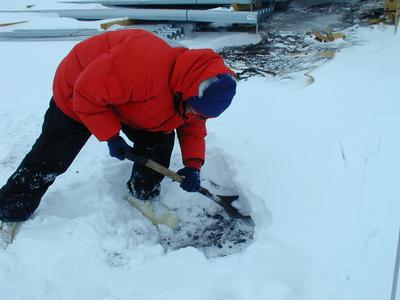
|
|
17 December, 2001
The storm is subsiding, but the weather is still pretty poor. We are back to condition 3. The station is getting back to normal. Roads are being cleared, vehicles are being dug out and the airport is being made ready for planes to start flying out again.
The team spent the morning packing up and preparing samples for shipment back to the states.
We also took the opportunity to visit the water power plant. This is where the sea water is converted to the water we use for drinking, cooking, bathing etc.
As the water comes in from the sea, it is first heated from 28 F, to 37 F. Then the water passes through a series of filters where coal, sand, gravel and other parcticles are filtered out. The water then passes through a long cylindrical tube where reverse osmosis occurs. That is, the water molecules are forced out of the sea water under high pressure. The water molecules pass through layers of very fine filters.
The water will go into one set of tubes and the brine (or salt) will go out to another container. After that, the pH of the water is adjusted by going through a calcium carbonate tank and then having soda ash injected into it. The final step is to chlorinate the water. The water plant processes 80 gallons of sea water per minute. From that, they get 28 gallons of water and 52 gallons of brine. It was interesting that every month the water plant does a coliform/Ecoli test on the water that is very similar to ours.

1. digging out from the storm
Contact the TEA in the field at
.
If you cannot connect through your browser, copy the
TEA's e-mail address in the "To:" line of
your favorite e-mail package.
|
